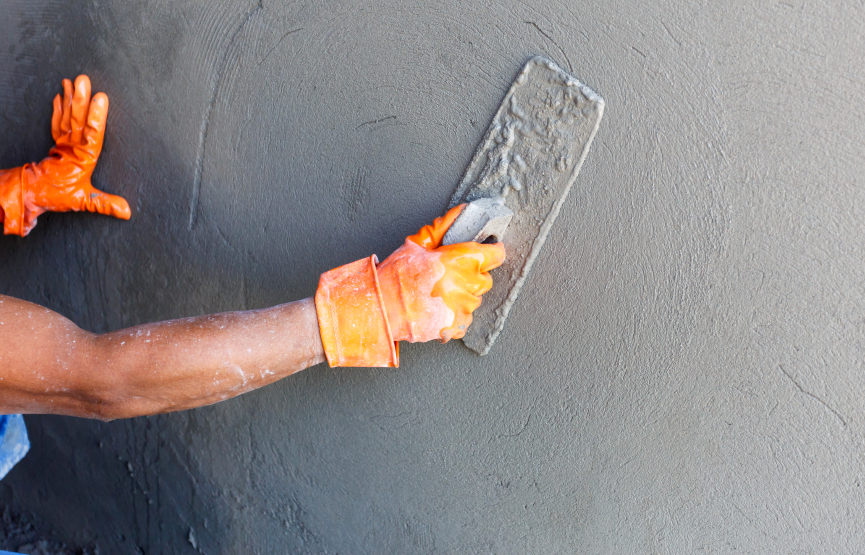Today there are more options than ever for recycling concrete. The construction, sand and gravel, and related industries have made a big push to capture and deal with this bulky material in a responsible manner. Their efforts are making a difference; in fact, one modern recycling machine can recycle over 140 tons of concrete per hour!
How can you recycle concrete from around your home? If you are involved in a remodeling project, you may be able to recycle and reuse your concrete onsite. If not, check with your local solid waste management agency to see if they accept concrete for recycling, or see if your community has a private company that can put it back to use. We also have a few good ideas for reusing concrete.
What is concrete?
Concrete is a mixture of cement and aggregate that has been crushed to a range of sizes, from very fine to somewhat chunky. When the mixture gets wet, the cement acts as a paste that holds the rock together and creates extremely strong structures.
To make concrete, a manufacturer needs to get the correct mix of cement and rock. According to the Portland Cement Association, the typical combination is 10-15% cement, 60-75% rock, and 15-20% water. (Portland refers to the type of cement, not the city.)
Concrete is heavily (pun intended) used in construction and may make up the foundation, driveway, sidewalk, even the walls of a home. It holds bricks and other types of building blocks together. It can be used in very large structures such as dams and skyscrapers, and very small things such as stepping stones and garden sculptures. In addition to its strength and versatility, the World Business Council for Sustainable Development points out that concrete is revered for its affordability, durability, natural fire resistance, and excellent thermal mass (which means it makes very energy efficient buildings). Producing concrete requires much less energy than some other types of building materials, including aluminum and steel.
Why should you recycle concrete?
There are a number of reasons to recycle concrete. First of all, it will take up a lot of space in a landfill, and it will never biodegrade.
When making new concrete, used concrete can be ground up and used to replace some of the other types of aggregate in the product. This is important because rock and gravel must be mined and transported to a construction site. Mining is water-intensive and tough on the land, so it’s good to avoid doing it whenever possible. Throw in the carbon emissions that come from transporting material (especially very heavy rock) and the environmental impact of your aggregate can be quite high.
Studies are beginning to show that including some recycled concrete in new concrete can actually improve its performance. CrushCrete,
a construction material recycling company in Bethlehem, Pennsylvania, shares a couple interesting facts. New concrete with some recycled content mixed into it performs better than an all-new product. Recycled concrete is actually lighter, which means it is less expensive to haul and less expensive to buy.
How to recycle concrete
Concrete is part of a recycling category called “construction and demolition” (or C&D) waste. For years, the only place that would take construction waste was the local landfill. Then governments and solid waste management companies got wise to how much space concrete, wood and other construction debris were taking up. Now, C&D waste is typically diverted to its own landfill or (even better) recycled. Companies and homeowners are finding that using recycled concrete saves them time and money as well as lowering their carbon footprint.
If you are involved in a construction project that involves demolishing a lot of concrete, see if your contractor can find a way to use it in the new structure. Old concrete can be broken up onsite using a portable crushing machine and used as an underlay to stabilize a roadbed or driveway. Large pieces can be used to build retaining walls.
Recycled concrete can be used in other projects around the home. Flat pieces can become stepping stones or be used to build planter boxes or garden beds (the material is very inert and will not leach chemicals into your soil). If you do not have a place to reuse concrete pieces around your house, the blog Apartment Therapy recommends calling an eco-minded landscaping company to see if they would like it for projects. Some of them are even willing to come pick up the material so you don’t have to load and haul it yourself.
If none of those are options for you, check to see if there is a place that will accept concrete for recycling in your community. That location may be a publicly sponsored recycling center like the Davis Street Transfer Station in Oakland. It could also be a private company like Braen Stone in Haleon, New Jersey, which takes old concrete and turns it into the Recycled Concrete Aggregate (RCA) that goes into recycled concrete.
